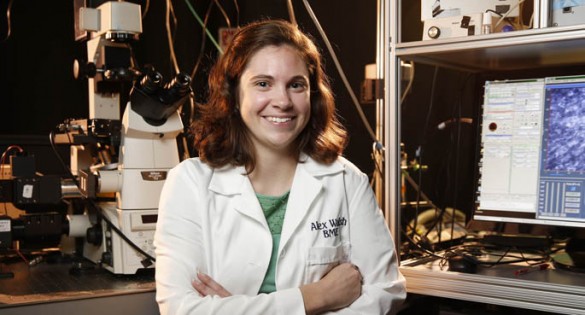
A group of Vanderbilt researchers has used laser technology and a custom-built multiphoton microscope to distinguish breast cancer subtypes and determine if specific therapies are working against the cancer cells in as little as two days.
The technology allows investigators to see how molecules “light up” through autofluorescence and to measure the molecules’ activity.
The study, led by Vanderbilt Ph.D. candidate Alex Walsh, was published in Cancer Research, a journal of the American Association for Cancer Research.
The new optical metabolic imaging (OMI) measures the metabolic activity in cells, which is how cells use sugar to create energy. Cancer cells generate energy in different ways than normal cells.
“By looking at the different ways the cells are metabolizing glucose we’ve been able to differentiate the different subtypes of breast cancer and also see how anticancer drugs are affecting the metabolism,” said Walsh, who works in the Department of Biomedical Engineering.
The technology Walsh and her colleagues used to study the metabolic activity of cells involved the multiphoton microscope and a titanium-sapphire laser. They used special filters to see the fluorescence emitted by two molecules — NADH (nicotinamide adenine dinucleotide) and FAD (flavin adenine dinucleotide).
“NADH and FAD are molecules that are present in every cell in the body, and when these molecules are excited with laser light, electrons jump to higher orbital levels,” said Walsh. “When they return to the normal states, instead of releasing the energy as heat, they emit fluorescent light.”
Using OMI, the investigators were able to capture images of cellular metabolism and to differentiate between estrogen receptor positive or negative breast cancer cells and HER2 positive or negative cells.
The investigators also used the technology to test the effects of anti-HER2 therapy trastuzumab in breast cancer cell lines, then grew human breast tumors in mice and treated some of the mice with trastuzumab. They were able to image the tumors in live mice and see a difference in response between trastuzumab-sensitive or resistant tumors as early as two days after the first dose of the cancer therapy.
“When you inhibit HER2, the cells change their metabolism in response and we were able to detect that change and use it to monitor how well the drugs were working,” said Walsh.
The new OMI technology can be used on tissues gathered during patient biopsies or surgery. With further development, it could be incorporated into other devices for live imaging of human cancers.
Investigators who participated in the study include corresponding author Melissa Skala, Ph.D., Rebecca Cook, Ph.D., H. Charles Manning, Ph.D., Donna Hicks, B.S., Alec Lafontant, B.E., and Carlos Arteaga, M.D.
The study was supported by grant funding from the National Cancer Institute, a division of the National Institutes of Health, (R00 CA142888, NCI SPORE in Breast Cancer (P50 CA098131), NSF Graduate Research Fellowship (DGE0909667; to A.J. Walsh), and the VICC Young Ambassadors Discovery Grant.
The VUMC Flow Cytometry Shared Resource and Translational Pathology Laboratory are supported by the Vanderbilt-Ingram Cancer Center (P30 CA68485) and the Vanderbilt Digestive Disease Research Center (DK058404). The VU Small Animal Imaging Institute is supported by NCI P30 CA068485.












